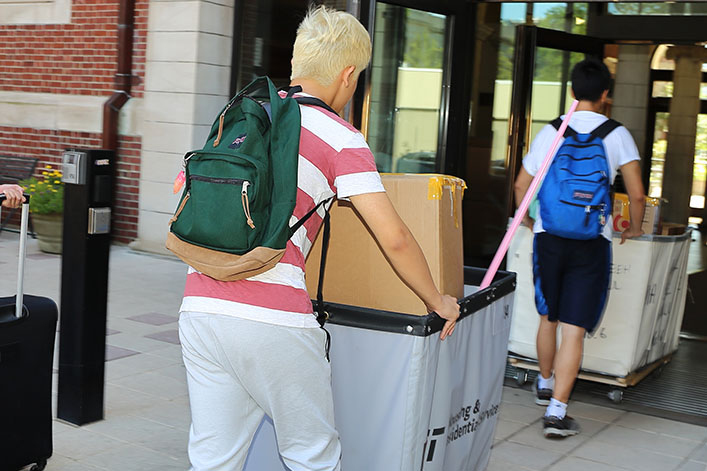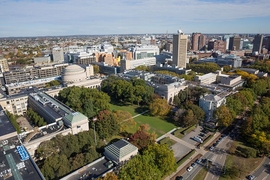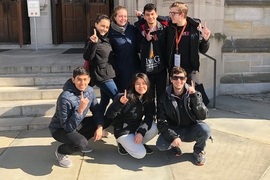Inside the cavernous 26-100 lecture hall, a team of staff works late into the night carefully reviewing students’ requests to live on MIT’s campus this fall. Unlike the typical scene in an MIT lecture hall — backpacks strewn around groups of friends sitting closely together in clusters of activity and chatter — this lecture hall is populated by only six staff members, scattered around the room, each wearing a virus-fighting face covering. Where there is typically a cacophony of voices, the only sounds are barely audible fluorescent buzz and quiet keyboard taps.
Welcome to the nearly silent nerve center of the Student Housing Assistance Review Process (SHARP).
In spring 2020, when Covid-19 struck and the world turned upside down, hundreds of undergraduate students petitioned to remain on campus because they could not travel, or their home life was not conducive to studying and learning remotely. That process was managed by a team of staff from the Office of the Chancellor and the Division of Student Life, drawn from a wide array of offices. “We had just hours to come up with a plan for students to petition to stay on campus,” says David Randall, senior associate dean for student support and well-being. "We were balancing public health requirements with caring for our most vulnerable students. It was hard for everyone."
So when MIT announced that primarily seniors would return to campus for the fall semester to keep the residence hall population density low in order to better protect the MIT community’s health, some of the same staff members were called on again to work with juniors, sophomores, and, in limited circumstances, first-years who requested to live on campus this fall. The big difference? A team of five undergraduate students and some key faculty members were part of the team, too. Students from the Undergraduate Association and its Committee on COVID-19, the Class Awareness, Support, and Equality (CASE) group, and the First Generation Program, helped shape the criteria and principles for SHARP and assembled resources to reduce worry and anxiety. They also talked with potential SHARP petitioners and offered perspectives that informed decisions on applications. Additionally, the SHARP team consulted with the faculty chairs of the Committee on Student Life and the Committee on Academic Performance on return requests.
The student representatives to SHARP were juniors Tanner Bonner, Hannah Collins, and Shaida Nishat, and seniors Kriti Jain and Andie Maloney. On the SHARP website, these peer counselors offered to provide “private, one-on-one video consultations” to “help students better understand SHARP and how the process works, reflect on their housing options, and connect students to additional resources that may be helpful.” Behind the scenes, they worked to help staff better understand how a student petitioning to return would be better off on-campus. "It's been especially important for me to serve as a member of the SHARP Advisory Group, as from firsthand experience I understand the disproportionate impacts that Covid-19 has had on some students in our community," Bonner says.
“All of us wish that the entire cohort of students could be on campus this fall, but pandemic-related public health and safety concerns make that impossible,” says Suzy Nelson, vice president and dean for student life. “The student leaders and counselors helped us navigate a situation that was deeply challenging for everyone involved, and I am grateful to them and everyone involved in SHARP.”
The new program was designed to help two groups of students: rising sophomores and juniors (and, in rare exceptions, first-years) who wished to request on-campus housing during the fall 2020 semester, and any undergraduates who were experiencing significant hardship and believed they absolutely could not live at home and could not live on campus. It opened on July 17 and closed on July 21. Of the 232 requests for on-campus housing submitted to SHARP, 90 percent were approved.
“The departure of the vast majority of our undergraduates midway through the spring semester was unsettling for faculty as well as students. We’re here for the students, and the Institute isn’t the same without them,” says Kristala L. J. Prather ‘94, Arthur D. Little Professor and Executive Officer of Chemical Engineering and outgoing chair of the Committee on Academic Performance. “I have great admiration for the thoughtful, caring work of the SHARP team that will return some of our students to campus. While the physical campus remains the same, we all understand that our collective experiences will be very different.”
An FAQ on MIT’s official Covid-19 website details those changes and more.
"I'm very grateful for the opportunity I've had so far to work with such a dedicated and compassionate group of individuals,” Bonner says. ”We're all in it for the same mission: protecting and meeting the needs of students, especially those most vulnerable."
“As hard as this work has been, the worst part was sitting in 26-100 without the echo of student voices, or walking down the Infinite Corridor without being jostled by students hustling from class to class,” Randall said. “The place is just not the same without our students. And while we know that the decisions for the fall are the right ones, we wish they were all here.”









